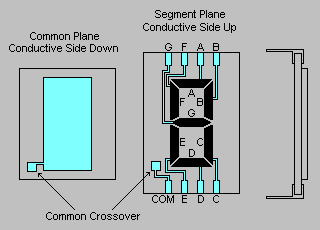
Static Drive LCD Technology
The configuration for Liquid Crystal Display Static Drive technique is that one side of all of
the Liquid Crystal Display segments are tied to a common, or backplane, and the other side of
each of the segments are routed to individual connection points that are
tied to the driver control circuitry. This method uses a large number of
interconnects and is not feasible for complex displays, but it does produce
the best looking display.

LCD's require an AC drive voltage with virtually no DC component. Segments
are controlled by the magnitude of the AC voltage across the LCD segment,
but there must always be AC voltage across ALL segments of the LCD.
Prolonged DC operation may cause electrochemical reactions inside the
displays which will cause significantly reduced life. The initial
indications of display degradation because of excessive DC current is a loss
of alignment along the edges of some of the characters. The visual
indication will be a "fuzzy" appearance of some of the characters.
The TN LCD is an RMS voltage responsive device, that is, the contrast of a
given segment is dependent upon the RMS value of the applied voltage across
it, measured with respect to the common plane. This fact, which seems
obvious now, is very important when discussing drive schemes.
Drive frequencies for direct drive displays are typically between 30Hz and
100Hz. Depending on the display size and design, displays can be operated at
higher frequencies, but this will result in increased power consumption.
LCDs portray a capacitive load, which reduces the load impedance as
frequency increases. However, operation below 30Hz typically results
in display flicker
LCD's can be
overdriven by a combination of voltage and frequency, which will result in
cross talk or "ghosting". Ghosting is the appearance or partial activation
of an "off" segment. This condition occurs when high drive voltage and
frequency are applied. Since the current is directly proportional to the
frequency, there is a voltage-frequency product which must not be exceeded.
These values are very dependent on the design and layout of any given part,
so proper display design and choice of driving conditions is important. It
is also very important that all unused segments be connected to the
backplane, and not allowed to float.